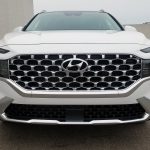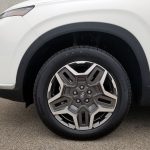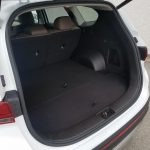
2021 Hyundai Santa Fe Hybrid Limited
 Class: Midsize Crossover SUV
Class: Midsize Crossover SUV
Miles driven: 479
Fuel used: 13.9 gallons
Real-world fuel economy: 34.5 mpg
| CG Report Card | |
|---|---|
| Room and Comfort | A- |
| Power and Performance | B- |
| Fit and Finish | B+ |
| Fuel Economy | A- |
| Value | A- |
| Report-card grades are derived from a consensus of test-driver evaluations. All grades are versus other vehicles in the same class. Value grade is for specific trim level evaluated, and may not reflect Consumer Guide's impressions of the entire model lineup. | |
| Big & Tall Comfort | |
| Big Guy | A |
| Tall Guy | A |
| Big & Tall comfort ratings are for front seats only. "Big" rating based on male tester weighing approximately 350 pounds, "Tall" rating based on 6'6"-tall male tester. | |
| Drivetrain | |
| Engine Specs | 226-hp 1.6-liter |
| Engine Type | Turbo 4-cyl hybrid |
| Transmission | 6-speed automatic |
| Drive Wheels | AWD |
Driving mix: 55% city, 45% highway
EPA-estimated fuel economy: 33/30/32 (mpg city, highway, combined)
Fuel type: Regular gas
Base price: $39,950 (not including $1185 destination charge)
Options on test vehicle: Cream White paint ($350), carpeted floor mats ($155)
Price as tested: $41,640
Quick Hits
The great: Comfortable, spacious cabin for passengers and cargo; generous list of comfort and safety features; nicely executed hybrid powertrain; quietness
The good: Nicely finished interior; competitive pricing; AWD comes standard
The not so good: Thick rear roof pillars impede rear visibility somewhat; brake-pedal action is occasionally non-linear
More Santa Fe price and availability information
John Biel
What’s new with the Hyundai Santa Fe midsize crossover SUV for 2021? Oh, not much aside from a stiffened body structure; refreshed styling to the grille, headlamps, fascia, and rear bumper/diffuser; a revamped interior with a new console that integrates audio/climate controls on a single panel, levers instead of dials for climate settings, buttons instead of lever transmission control, and a purse porch under the console; a top-line Calligraphy trim level; and new engines that include a gas/electric hybrid powerplant.

Consumer Guide’s test of a ’21 Santa Fe came in one of the three available hybrids, the top-line Limited with a starting price (including delivery) of $41,135. Other versions are the Blue ($34,835) and SEL Premium ($38,785). All come with a 1.6-liter turbocharged 4-cylinder gas engine paired with a 44.2-kW electric motor, a 6-speed automatic transmission, and HTRAC torque-allocating all-wheel drive. With only premium Cream White paint and a set of carpeted floor mats tacked on, the test truck peaked at $41,640.
The lure of hybrids is, of course, improved fuel economy. EPA estimates for the Limited and SEL Premium are 33 mpg in city driving, 30 mpg in highway use, and 32 combined. (Respective figures for the Blue are 36/31/34.) When this driver put 71.3 miles on the test vehicle with 64 percent city-type operation, it returned 30.8 mpg.
Test Drive: 2021 Kia Sorento SX Prestige X-Line

Generating 226 system horsepower, performance from the hybrid unit is modest—not disappointing, just modest. That said, selecting “Sport” drive mode elicits punchier, more eager throttle response. Electric-to-gas transitions are hardly noticeable. Perched on 19-inch alloy wheels (the other hybrids get 17s), the Limited rides smoothly, tackles bumps pretty well, and handles easily with nice body control in curves and transitions, even if steering isn’t overly communicative. Brake-pedal feel is subject to the less-than-satisfying regenerating hybrid experience, but in the end the Santa Fe hybrid brakes without worry.
First Spin: 2022 Nissan Pathfinder

Even with its myriad changes the current Santa Fe is, at its core, a continuation of the fully redone 2019 model. The 2-row SUV boasts fine leg- and headroom throughout, with space for a middle passenger in the rear row (though perhaps not an adult) thanks to a low floor hump. The backs of the 60/40-split rear seats are manually adjustable. Passenger entries and exits are easy, and drivers see well to nearly every point but the rear corners. Cabin storage for incidentals benefits from a large glove box and a covered console cubby with an adjustable tray. The console is home to a pair of exposed cup holders, a bay for the wireless charger and device inputs, and a bin for small items—and its new upswept shape allows for the floor-level space below. A storage pouch has been added to the back of the driver’s seat, joining the one previously provided on the front-passenger seat. Cup holders are set in the rear center armrest.
The main cargo bay, accessible through a wide rear opening, loads at bumper height, where 36.4 cubic feet of space reside behind the second-row seats. Under the floor—forward, near the seats—is a foam divider in three large segments for secure small-item storage. Retracting the rear seats expands the load area to 72.1 cubic feet. When the seats are folded, the cushions lower slightly, which helps to lower the seat backs flush with the rear cargo floor for easy loading.
Test Drive Gallery: 2021 Mazda CX-9 Signature

Luxury-oriented standard features in this pinnacle of the Santa Fe hybrid trio include leather upholstery, heated seats all around, ventilated front seats, heated leather-wrapped steering wheel, LED lighting inside and out, panoramic sunroof, hands-free height-adjustable liftgate, power front seats with driver’s-seat memory, 12.3-inch digital instrument cluster, a 360-degree surround-view monitor, auto-dimming rearview mirror, keyless entry and starting, and remote “Smart Park” function. Infotainment functions are accessed through a 10.25-inch touchscreen. The system includes navigation and Harman Kardon premium audio on which to hear HD and satellite radio. With the shift to a new unified control panel, tuning and volume knobs have been moved from the display screen. It’s still easy to input stations, but when the radio is playing you still have to push the “Radio” button to see the display, which seems like it ought to be the default once the radio is on and until you call for some other display. Apple CarPlay/Android Auto smartphone compatibility is included as well. The dual-zone climate system has switched out its convenient dials for temperature selection in favor of repetitive-push toggle levers. Since all the cool kids are abandoning true shift levers, Hyundai has done it too, going to an array of push buttons on the console.
Quick Spin: 2020 Toyota Highlander Hybrid Platinum

For safety’s sake, Hyundai’s “SmartSense” technology suite brings forward-collision warning with automatic emergency braking and pedestrian detection, blind-spot monitor, lane-keep assist, rear cross-traffic alert, automatic high-beam headlights, adaptive cruise control with stop and go capability, driver-attention warning, and “Safe Exit Assist” that uses radar to detect vehicles approaching from the rear to guard against passengers leaving the car into traffic. There’s also a parking-distance warning system with rear automatic braking, “Rear Occupant Alert” to reminds drivers to check the rear row when exiting, and “Blind View Monitor” that displays a camera view (in the instrument cluster) of the area alongside the vehicle when a turn signal is activated.
One interesting fact about the new hybrids is that they are priced within—and not above—the overall Santa Fe model mix. (Indeed, the hybrid Limited starts at $350 less than the gas Limited with all-wheel drive.) That stands to make it lots more popular with shoppers who want to maximize value by getting a comfortable and useful crossover SUV with good fuel economy.
Test Drive: 2020 Volkswagen Atlas Cross Sport

Check out the Consumer Guide Car Stuff Podcast
2021 Hyundai Santa Fe Hybrid Limited Gallery
(Click below for enlarged images)
Consumer Guide Car Stuff Podcast, Episode 57; 2021 Consumer Guide Best Buys















